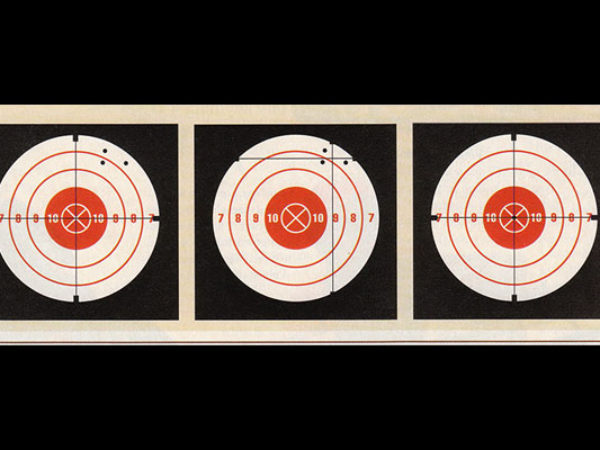SCOPED RIFLE SIGHT-IN MADE EASY
Sighting in a new scope on a rifle or slug shotgun can be an intimidating chore. You probably imagine yourself spending an afternoon at the range, shooting up a box of ammunition, and returning home with a sore shoulder.
Believe it or not, you could probably zero in your scope with just six shots or less.
The most frustrating part of sighting in a scope can be just getting your shots on paper. If you don’t know where your rifle is shooting, you don’t know what adjustments to make.
You can eliminate that aggravation by using a collimator or boresighter, an optical device that enables you to put your bore and scope in approximate alignment. Collimating your rifle in this way probably will not put your bullets in the bull’s-eye, but it will put your bullets on the paper.
Boresighters are available from several optics manufacturers, including Leupold, Bushnell, Cabela’s, Laserlyte, and Simmons generally in the $69 to $200 range.
You can also take your rifle and scope to a gun shop or gunsmith for collimating. It may be a free service with the purchase of a scope or rifle, or there may be a charge of a few dollars. If there is a charge, it will save you that much in ammunition and save your shoulder a lot of punishment, as you shoot trying to get on paper.
Because your rifle will shoot different loads to different points on a target, use exactly the same ammunition to sight in your rifle with which you plan to hunt. This is not the time to shoot up those miscellaneous rounds you have been accumulating for years.
Even if you are not mounting a new scope, you may need to check your rifle’s zero. If work has been done on your rifle, or it has been loaned to someone, or if your rifle has taken a hard fall, or has been left sitting in your gun safe all summer, it may not shoot the same as it did last year. Some scopes stay on for years others move for, seemingly, no reason at all. Annually the scoped rifle needs to be checked by shooting.
Take the time to check your rifle’s zero each year just before hunting season and any other time your scope may have been jarred or disturbed. If it is not shooting where you are aiming, use this six-shot sight-in method. It can save time and money.
From a sandbag rest, fire three carefully aimed shots at a target 100 yards downrange. With the rifle unloaded, go to the target and mark each of the three holes with a black marker so they can be seen easily.
Return to the shooting bench, place the rifle in a sturdy rest, and aim the unloaded rifle at the target again. Holding the rifle steady, look through the scope and move the vertical cross wire from the bull’s eye to the center of the three-shot group. Next, move the horizontal cross wire from the bull’s eye until it is in the center of the three-shot group. It is essential that the rifle be held securely during these adjustments. A helper or a shooting vise will probably make this easier.
Now load and shoot one more carefully aimed shot at the bulls eye. It should be in or near the bull’s eye. If not, do the same adjustment – carefully adjust the cross wires from the bull’s eye to the hole. Now your rifle should be dead-on at 100 yards.

